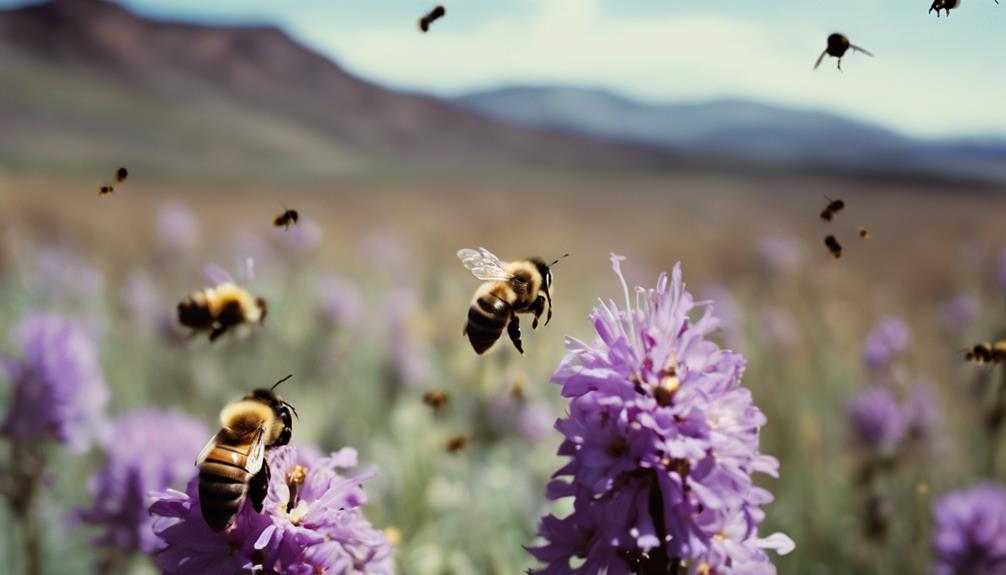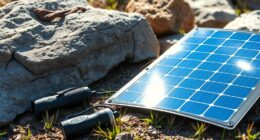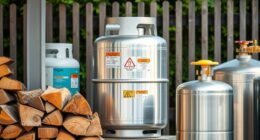You can forage in California, but it's crucial to understand the state's laws, regulations, and sustainable practices to establish a harmonious relationship between humans and the environment. Familiarize yourself with local regulations, respect the environment, and learn from experienced foragers to promote responsible foraging. California offers a diverse range of wild edibles, including coastal succulents, berries, and mushrooms. To forage safely, educate yourself on safe-to-eat plants, follow established protocols, and research local guidelines. As you explore foraging in California, you'll uncover more about the state's unique ecosystems, sustainable practices, and the richness of its wild edibles.
Key Takeaways
- Foraging laws and regulations vary by location in California, specifying harvestable species and often restricting activities in state parks.
- Sustainable foraging practices involve taking only what's needed, respecting the environment, and balancing harvesting with conservation.
- Proper education on guidelines and safe foraging practices is crucial to avoid harming ecosystems and ensure responsible foraging.
- California offers diverse wild edibles, including coastal succulents, beach greens, and berries, as well as inland plants like purslane and dandelions.
- Seasonal foraging opportunities rotate throughout the year, providing a variety of fresh, nutrient-dense wild foods in each bio-region.
Foraging Laws and Regulations
When foraging in California, you must familiarize yourself with the state's laws and regulations, which vary by location and species, to make certain that your harvesting practices are sustainable and environmentally responsible.
Foraging laws in California regulate the harvesting of wild plants to protect the environment and native species. These regulations aim to guarantee sustainable foraging practices and minimize ecological impact.
As a forager, you must adhere to laws that vary by location and specify which species can be harvested. It's important to note that California state parks and wilderness areas often have restrictions on foraging activities. Additionally, foraging laws in Colorado parks are similarly stringent, often limiting the types and quantities of species that can be collected. These regulations are designed to preserve local ecosystems and ensure the sustainability of native plant and animal populations. Always research and follow local guidelines to avoid fines or inadvertently harming protected species.
Proper education on foraging laws and guidelines is vital to promote responsible foraging practices. By understanding the regulations, you can enjoy the bounty of California's wild plants while preserving the environment for future generations.
Native Edibles of California Coast

As you explore the California coast, you'll discover a treasure trove of native edibles waiting to be discovered.
From coastal succulent delights to beach greens galore, and seaside berry bounty, the Golden State's coastline offers a diverse array of foraging opportunities.
Let's take a closer look at these unique and flavorful finds that await you on your coastal foraging adventures.
Coastal Succulent Delights
While exploring California's coastline, you'll discover a treasure trove of coastal succulent delights, offering a diverse range of flavors and textures to elevate your foraging experience.
As you venture into the world of foraging, you'll find an array of coastal succulents that aren't only edible but also packed with nutrients. Sea purslane and ice plant, for instance, boast leaves rich in vitamin C, making them a great addition to your meals.
If you're looking for a salty, crunchy snack, sea beans are the way to go. Sea rocket, with its peppery leaves, adds a burst of flavor to salads and dishes. And, if you're feeling adventurous, try incorporating sea fennel into your recipes – its aromatic leaves will transport your taste buds to the coast.
Foraging for coastal succulents in California offers a unique opportunity to explore the state's native edibles, and with a little practice, you'll be savoring the flavors of the coast in no time.
Beach Greens Galore
Along California's coastline, you'll frequently stumble upon a diverse array of beach greens, offering a unique culinary experience that's both nutritious and sustainable. These edible plants have been a staple for Native Americans, who foraged them for their nutritional value and sustainability. Beach greens like sea beans, sea rocket, and ice plant are commonly found along the California coast, rich in vitamins, minerals, and antioxidants.
| Beach Green | Description | Nutritional Value |
|---|---|---|
| Sea Beans | Crisp, salty, and succulent | Rich in vitamins A, C, and K |
| Sea Rocket | Peppery, slightly bitter | High in antioxidants and fiber |
| Ice Plant | Fleshy, slightly sweet | Rich in vitamins A and C, potassium |
When foraging in California, you can incorporate these beach greens into your dishes, enjoying a unique culinary experience. From salads to sautés, these edible plants will add a burst of flavor and nutrition to your meals. By foraging for beach greens, you're not only reducing your carbon footprint but also supporting a sustainable food system. So, get out there and start exploring California's coastline for these delicious and nutritious beach greens!
Seaside Berry Bounty
You'll discover a treasure trove of seaside berries, including salal, huckleberries, and salmonberries, growing wild and ripe for the picking along California's scenic coastline. These wild berries are a forager's delight, offering a sweet and tangy taste experience.
As you explore the coastal region, you'll find a variety of plants that can be foraged, including sea rocket, sea lettuce, and sea beans. The California coast is a prime location for foraging wild berries and coastal plants with unique flavors.
Seaside foraging provides opportunities to harvest nutritious and flavorful wild foods, rich in antioxidants and vitamins. You can indulge in these foraged foods, knowing you're getting the best of what nature has to offer.
With the right knowledge and skills, you can enjoy the bounty of California's coastline, savoring the flavors and aromas of these wild treasures. So, get ready to forage and discover the seaside berry bounty that California has to offer!
Missionaries' Impact on Ecosystem

As you explore California's ecosystem, you'll notice that the arrival of missionaries had a profound impact on the environment. You'll discover that their introduction of non-native plants disrupted native habitats, and their farming practices upset the ecological balance.
Now, let's examine the specific ways in which missionaries' actions created an ecological unbalance, altered farming practices, and disrupted native habitats.
Disruption of Native Habitats
When European missionaries arrived in California, they unknowingly brought with them a host of non-native plant species that would forever alter the region's delicate ecosystem. As you explore California's wilderness, it's important to understand the impact of these non-native plants on the local environment.
The introduction of these species disrupted the native habitats, altering the natural balance and biodiversity of the region. You'll notice that many of these non-native plants have outcompeted native species for resources, leading to a decline in native flora and fauna.
The presence of these plants has changed the California landscape, affecting native species and their habitats. The disruption of native habitats is a direct result of missionary activities, which introduced invasive species that have had a lasting impact on the ecosystem.
As you forage in California, it's vital to recognize the consequences of these actions and appreciate the delicate balance of the region's ecosystem.
European Farming Practices
The European missionaries' farming practices, which included the introduction of non-native plants, not only disrupted native habitats but also transformed the way Californians produced and accessed food, ultimately altering the region's ecosystem and affecting foraging opportunities.
As you explore the history of foraging in California, you'll find that European farming practices played a significant role in shaping the state's ecosystem. The introduction of non-native plants, for instance, altered the biodiversity of native food sources, impacting the availability and distribution of foraged foods.
You may wonder how this affected the native communities. Well, the ecosystem changes brought about by European farming practices presented significant challenges to Native American communities, who'd to adapt to a new environment.
Today, the impact of these practices still resonates, influencing the foraging opportunities you have in California. As you venture out to forage, remember that the ecosystem changes brought about by European farming practices continue to shape the landscape of foraged foods, making it essential to be aware of the historical context that has led to the current state of foraging in California.
Ecological Unbalance Created
Understanding the impact of missionaries on the ecosystem is crucial as you explore California's natural landscape.
The introduction of new plant species by missionaries caused ecological imbalances, which in turn affected the region's biodiversity. This disruption had a ripple effect, altering the natural habitats and changing the way native Californians practiced foraging.
In contrast, Native California Indians had sustainable foraging practices that coexisted with the natural environment.
The missionaries' actions highlight the importance of comprehending historical influences on foraging in California. You can see the lasting impact of their actions on the ecosystem today.
As you venture into California's wilderness, remember the delicate balance of the ecosystem and the importance of preserving it for future generations. By acknowledging the past, you can make more informed decisions about your own foraging practices and contribute to maintaining the region's biodiversity.
Sustainable Foraging Practices

You'll want to adopt sustainable foraging practices to make sure that the plants you harvest today will still thrive tomorrow. This means taking only what you need, respecting the environment, and minimizing your impact on natural habitats. By doing so, you'll help protect native species and preserve ecosystems.
| Sustainable Foraging Tips | Why It Matters |
|---|---|
| Take only what you need | Prevents over-harvesting and allows plants to regenerate |
| Respect the environment | Preserves natural habitats and ecosystems |
| Learn from experienced foragers | Guarantees safe and responsible foraging practices |
| Balance foraging with conservation | Maintains ecological balance and promotes sustainability |
California's Wild Edible Plants

From coastal dunes to mountain meadows, California's diverse landscapes harbor a stunning array of wild edible plants waiting to be discovered. As you venture into the world of foraging in California, you'll find an abundance of wild edible plants that can elevate your culinary game. You might stumble upon purslane, nettles, lambs quarters, dandelions, chickweed, clover, and sow thistle, all of which are ripe for the picking. These plants aren't only delicious but also packed with nutrients, offering a rich source of flavors and nutrition.
As you explore California's wild edible plants, remember that foraging isn't just about finding food; it's also about connecting with nature and respecting the environment. You can find guidance on responsible foraging practices and identification tips from resources like the Arcadianabe blog, which specializes in foraging in the Pacific Northwest.
When foraging in California, keep in mind that you might even stumble upon fresh roadkill as a potential food source. With California's diverse regions offering a wide range of wild edible plants, the possibilities are endless. So, grab your basket and get ready to discover the flavors of the Golden State!
Where to Find Wild Mushrooms

As you venture into California's diverse landscapes, you'll uncover a vast array of habitats teeming with wild mushrooms, from the misty forests of the north to the sun-kissed grasslands of the south.
From forests to grasslands, and even urban areas, California offers a wide range of environments where wild mushrooms can thrive. As a forager, having a good understanding is crucial to know that not all wild mushrooms are edible, and some can be toxic, even lethal if ingested.
In California, you can find popular edible species like chanterelles, morels, porcini, and hedgehog mushrooms. However, you must be cautious and knowledgeable about mushroom identification to avoid mistaking a toxic mushroom like the death cap or destroying angel for an edible one.
Foraging for wild mushrooms in California requires a deep understanding of mushroom habitats, identification, and safety precautions to avoid poisoning. By doing your research and exercising caution, you can enjoy the bounty of California's wild mushrooms while staying safe.
Seasonal Foraging Opportunities

California's seasonal rhythms bring a constant rotation of wild foods, and you can tap into this bounty by foraging for nuts, greens, mushrooms, berries, and seaweeds at different times of the year.
As you explore California's diverse landscape, you'll discover unique wild foods in each bio-region, varying with the seasons. From urban areas to mountainous regions, you can find fresh, seasonal foods year-round.
The state's temperate climate and diverse topography make it an ideal location for foraging 365 days a year. By foraging seasonally, you'll not only enjoy the thrill of the hunt but also reap the health benefits of consuming fresh, nutrient-dense wild foods.
Whether you're a seasoned forager or just starting out, California's seasonal foraging opportunities offer a world of possibilities. By tuning into the natural cycles of the state's wild foods, you can indulge in a constant rotation of flavors, textures, and aromas, all while enjoying the great outdoors and the many health benefits that come with foraging.
Foraging Safety and Precautions

When you head out to forage, remember that respecting the environment and its inhabitants is essential, so take only what you need, leaving enough to make sure the plants can regenerate and thrive. This approach guarantees the long-term sustainability of the ecosystem.
As you forage, consider the entire environment, not just the plants you're after. Be mindful of the impact your actions have on the ecosystem as a whole. Educating yourself on safe-to-eat plants and learning from experienced foragers is vital to avoiding mistakes that can harm you or the environment.
Following established protocols and laws for foraging helps protect the environment and native species. Don't assume that just because you've seen someone else foraging in an area, it's okay to do so. Research and understand local regulations and guidelines before you start foraging.
Responsible Foraging in California

What does it take to forage responsibly in California, where the delicate balance between nature and human activity demands careful consideration? As you venture out to forage, remember that California's laws regulate foraging to protect the environment and native species. You must respect nature and the right to pick wild plants, making sure that your actions don't harm the ecosystem.
Here are some key guidelines to keep in mind:
| Responsible Foraging Practices | Why It Matters | What You Can Do |
|---|---|---|
| Learn about local regulations | Laws protect California's environment | Research and comply with local laws |
| Respect protected areas | Preserve ecological balance | Avoid foraging in state parks and wilderness areas |
| Harvest sustainably | Ensure plant regeneration | Only pick what you need, and leave some for others |
| Educate yourself | Minimize environmental impact | Learn about plant identification and sustainable foraging |
| Be mindful of your impact | Preserve native species | Avoid over-foraging and respect the environment |
Frequently Asked Questions
Is It Legal to Forage in California?
You're wondering if it's legal to forage in California, and the answer is yes, but with some caveats – you'll need to navigate varying regulations, permits, and restrictions depending on the location and type of plant you're after.
What Is the Number One Rule of Foraging?
As you commence on your foraging journey, remember that the golden rule echoes loudly: positively identify plants, or risk a bitter taste of disaster. You must be absolutely sure, no exceptions, to avoid toxic twins.
What Should You Avoid When Foraging?
When foraging, you should avoid contaminated areas, toxic look-alikes, protected species, private property without permission, and unclear identifications to guarantee a safe and responsible foraging experience, protecting both yourself and the environment.
Is Foraging Considered Hunting?
You might think foraging is like hunting, but it's not! Foraging involves gathering wild edibles like plants, mushrooms, and fruits, unlike hunting, which targets animals for food; you're more of a gatherer than a hunter.
Conclusion
As you venture into California's wilderness, remember that foraging is a symbiotic relationship between you and nature. Be the gentle gardener, not the reckless harvester.
By respecting the land, native edibles, and fellow foragers, you'll reap a bounty of flavors and memories.
Forage with care, and the Golden State's wild treasures will flourish, much like a well-tended garden, yielding a harvest of wonder and discovery.










